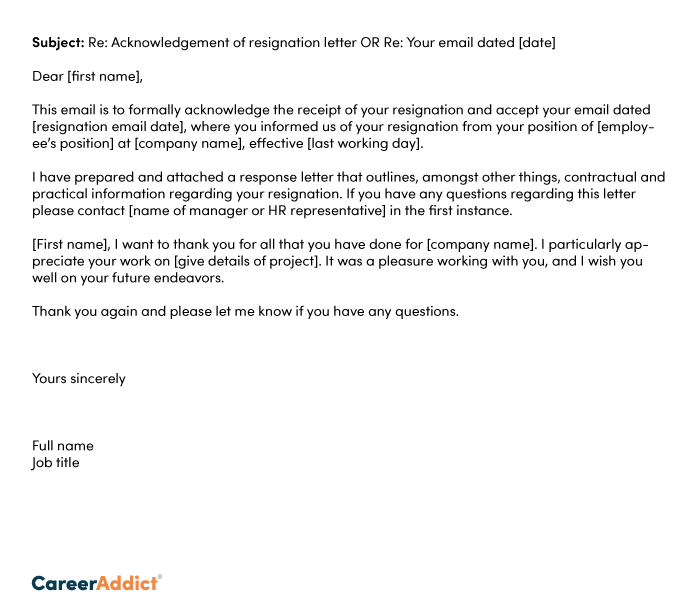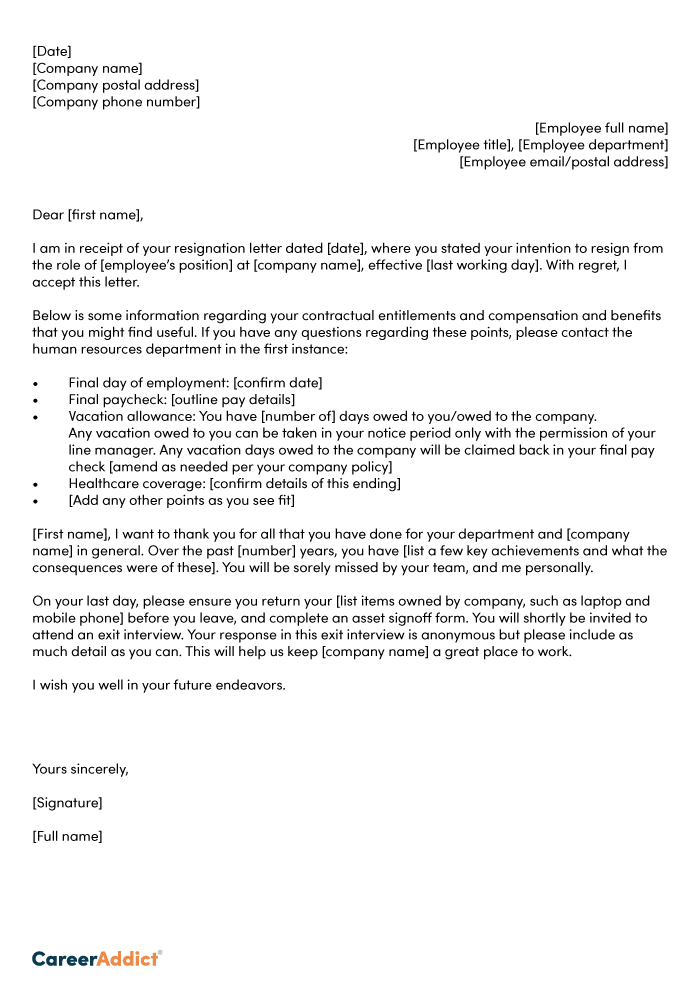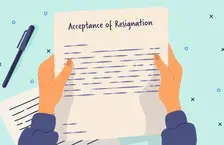At some point, you will need to manage an employee who has resigned from their position. This begins with acknowledging their letter of resignation. This is an overlooked but critical step in the resignation process, and in wider human resource management practice, as it gives you the chance to formalize the situation and recognize the employee for the great work they have done.
Writing resignation acceptance letter isn’t easy, as it needs to be sincere but also outline important information. This article covers why a response to an employee’s resignation letter is important, and how to write one.
TABLE OF CONTENTS
Why you need to write a response
There are both practical and moral reasons for responding to an employee’s resignation letter. Practically, a response letter confirms that you have received the employee’s resignation and accept it. Given that the employee will usually specify a last day of employment in the letter, you need to confirm that you agree to this date. You will also be able to outline any relevant contractual terms during the notice period, so to this end, a response letter will proactively address any potential misunderstandings.
Morally, a response letter to a resignation is your opportunity to thank the employee leaving your company for their hard work, recognize their contributions, and wish them well for the future. The employee will appreciate this personal touch and might also mention it to their colleagues, which will help you in being perceived as a respectful and empathic manager.
Tips for responding to a resignation letter
A resignation letter needs to be easy to digest but also contain lots of meaningful information. It helps to have a template or HR policy saved so you can work off a consistent document to ensure you don’t forget anything. Here are five tips for responding to an employee’s resignation letter.
1. Write one as soon as you can
It is important to write a response to a resignation letter as soon as you can after the employee has resigned. This will put the employee’s mind at rest that you have acknowledged their resignation. The information contained in the letter (discussed below) will be important for the employee to understand, so getting the letter to them quickly will ensure they have time to prepare for their departure.
Responding to a resignation letter as soon as you can gives the employee more time to come to you with any questions and concerns they might have (and it will also give you more time to see if there’s any chance to retain the employee). You might wish to invite the employee to an exit interview to discuss these in more detail.
2. Include contractual information
Responding to a resignation letter will give you a chance to outline all the formalities an employee needs to be aware of once they tell you they’re leaving. When an employee resigns, they are effectively breaking their contract and responding to this tells the employee you agree to this.
You can use the response letter to confirm the notice period, which in many cases is also contractual, and inform the employee that you accept their proposed last day of work. You can also outline any outstanding vacation to be paid (or to be taken), private healthcare arrangements, or if the employee owes you any money if they have taken too many holiday days. Finally, you can ask that the employee return any hardware, such as a mobile phone or laptop.
3. Address any questions or concerns the employee may have
Many employee resignation letters are quite short and sweet, however other employees might ask many different questions when they resign. They might also use the letter to inform you of a performance concern or complaint that might have led to them resigning, or simply leave some feedback about the working environment. Your response to the employee’s resignation letter gives you the chance to respond to these questions, and if you are unable to do so in a reply, confirm that you have understood them and invite the employee to a meeting to learn more.
4. Be supportive and sincere
Responding to an employee’s resignation letter is an opportunity to show that you care about them and will miss working with them. Use your response to tell the employee that you are sorry to see them leave and thank them for their service and achievements.
Try to make this section of the letter as personal as you can, to show the employee that you understand the impact they have made. Finally, for those employees who you might wish to try to retain, include a line at the end that asks if there is anything you can do to encourage them to stay.
5. Keep a record of the letter
Because of its contractual importance, it is important to keep a record of the response letter, as well as any subsequent communication that might occur afterwards. If you have an HR department, then ensure the letter is passed to them. Otherwise, a copy of the letter can be placed in the employee’s personnel file.
How to write an email response
If you receive resignation letters via email, you can respond in kind. This will begin with an appropriate subject line. You can simply reply to whatever subject line the employee chose, or you might want to create your own, such as:
Subject: Re: Acknowledgement of resignation letter
If you are concerned about confidentiality or that other people have access to the employee’s emails and don’t want to reference the resignation in the subject line, then you can use:
Subject: Re: Your email dated [date]
The best approach to confirm a resignation via email is to write a short email confirming and accepting the resignation and include an attachment to a more comprehensive PDF letter (detailed below) outlining all pertinent terms — otherwise the email will be too long. You can create a short second paragraph in the email outlining your appreciation for the employee’s work, and direct to them an appropriate resource if they have questions.
As you write the email response, ensure it is written well, and keep sentences short to suit people reading on a screen. When you send the email, include a delivery/read receipt and save this once received.
Below is an example of what an email reply to a resignation letter might look like:

How to write a letter response
An effective letter replying to an employee’s resignation will begin with formally accepting the resignation. Next, you will want to outline practicalities, such as notice period or final day of work, and any other contractual information to be aware of.
After this, in the second paragraph you can spend some time outlining what the employee has personally and professionally achieved and thank them for their service.
In the final paragraph, reiterate your thanks and communicate what the employee should expect next, for example, an invite to an exit interview, or when to expect any post-employment documentation. Include the contact information of anyone best placed to provide guidance on resignation matters, such as HR.
Ensure you remain professional and adhere to letter-writing structure, such as an address line and an appropriately addressed sign-off.
Below is an example of what a written reply to a resignation letter might look like:

Key takeaways
Handling an employee resignation correctly is an important aspect of HR management. As you have read, there is plenty to consider when writing a response to an employee’s resignation letter. Here are some of the key things to remember:
- Have a resignation response letter template (like the one we gave above) ready, to make writing this a little more straightforward and consistent for all leavers.
- Write the letter as soon as you can.
- Use a PDF copy of the written letter if acknowledging a resignation via email.
- Include all contractual information.
- Always wrap up with thanking the employee, recognizing their work and bidding them a fond farewell.
If you keep these points in mind, you will be able to write a meaningful and useful resignation response letter that closes off employment in all the right ways.
If you found this article useful, please share it with your fellow HR managers and colleagues, as we’re sure it’ll come in handy!
